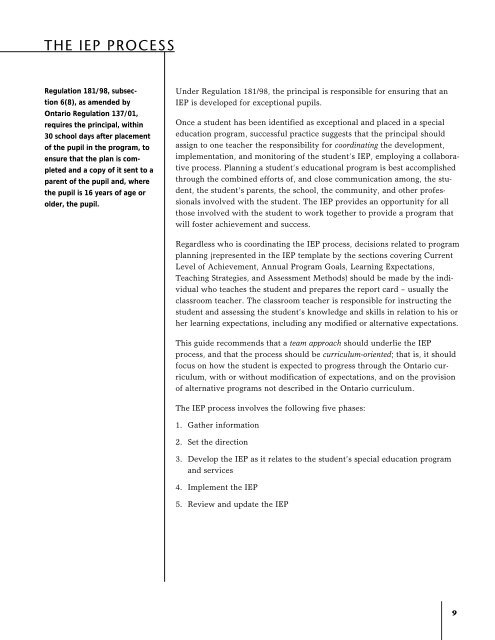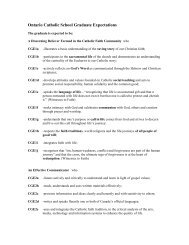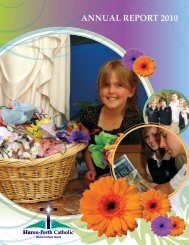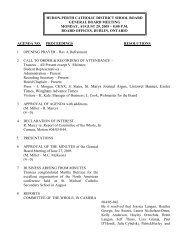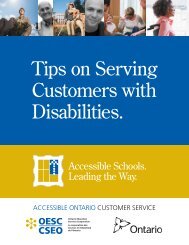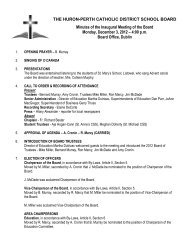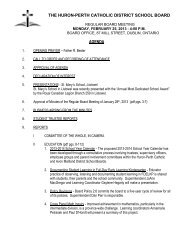The Individual Education Plan (IEP) - A Resource Guide, 2004
The Individual Education Plan (IEP) - A Resource Guide, 2004
The Individual Education Plan (IEP) - A Resource Guide, 2004
You also want an ePaper? Increase the reach of your titles
YUMPU automatically turns print PDFs into web optimized ePapers that Google loves.
THE <strong>IEP</strong> PROCESS<br />
Regulation 181/98, subsection<br />
6(8), as amended by<br />
Ontario Regulation 137/01,<br />
requires the principal, within<br />
30 school days after placement<br />
of the pupil in the program, to<br />
ensure that the plan is completed<br />
and a copy of it sent to a<br />
parent of the pupil and, where<br />
the pupil is 16 years of age or<br />
older, the pupil.<br />
Under Regulation 181/98, the principal is responsible for ensuring that an<br />
<strong>IEP</strong> is developed for exceptional pupils.<br />
Once a student has been identified as exceptional and placed in a special<br />
education program, successful practice suggests that the principal should<br />
assign to one teacher the responsibility for coordinating the development,<br />
implementation, and monitoring of the student’s <strong>IEP</strong>, employing a collaborative<br />
process. <strong>Plan</strong>ning a student’s educational program is best accomplished<br />
through the combined efforts of, and close communication among, the student,<br />
the student’s parents, the school, the community, and other professionals<br />
involved with the student. <strong>The</strong> <strong>IEP</strong> provides an opportunity for all<br />
those involved with the student to work together to provide a program that<br />
will foster achievement and success.<br />
Regardless who is coordinating the <strong>IEP</strong> process, decisions related to program<br />
planning (represented in the <strong>IEP</strong> template by the sections covering Current<br />
Level of Achievement, Annual Program Goals, Learning Expectations,<br />
Teaching Strategies, and Assessment Methods) should be made by the individual<br />
who teaches the student and prepares the report card – usually the<br />
classroom teacher. <strong>The</strong> classroom teacher is responsible for instructing the<br />
student and assessing the student’s knowledge and skills in relation to his or<br />
her learning expectations, including any modified or alternative expectations.<br />
This guide recommends that a team approach should underlie the <strong>IEP</strong><br />
process, and that the process should be curriculum-oriented; that is, it should<br />
focus on how the student is expected to progress through the Ontario curriculum,<br />
with or without modification of expectations, and on the provision<br />
of alternative programs not described in the Ontario curriculum.<br />
<strong>The</strong> <strong>IEP</strong> process involves the following five phases:<br />
1. Gather information<br />
2. Set the direction<br />
3. Develop the <strong>IEP</strong> as it relates to the student’s special education program<br />
and services<br />
4. Implement the <strong>IEP</strong><br />
5. Review and update the <strong>IEP</strong><br />
9


